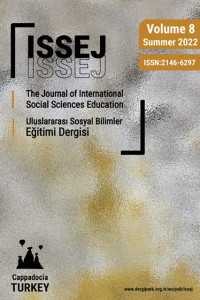Written Grammatical Errors of Turkish Adult Learners of English: An Analysis
Making errors is a natural process of language learning. As in all kind of learning, language learning also involves making errors. Research has shown that even in the first language acquisition process, children make countless errors. Similarly, adult learners of English will inevitably make errors until they have mastered the rules of target language. In this respect, this study was conducted to examine written grammatical errors of 2nd year Turkish students majoring in English Language Teaching at Anadolu University. First, related literature has been reviewed in the study. Both descriptive and qualitative research design has been used in order to collect data to be analyzed. The students were asked to write a narrative essay about a video they had watched. All the essays were analyzed one by one to identify all the grammatical errors of the students by three inter-raters. The raters identified grammatical errors manually and reached on a consensus in the categorization process. The only concern of the study was to analyze grammatical errors; this is why, ICLE/ Louvain Taxonomy of Errors (Diaz-Negrillo & Fernandez-Dominguez, 2006) was used partly in the categorization of the errors. The study reported that preposition errors were the most common grammatical errors among Turkish learners of English followed by respectively verb errors, article errors, word class errors, pronoun errors and others. In the light of previous literature, the findings indicate that interference effect and developmental process might have been the reason for the grammatical errors.
Anahtar Kelimeler:
grammar errors, narrative essays, Turkish students
İngilizce Öğrenen Yetişkin Türk Öğrencilerin Yazılı Dilbilgisi Hatalarının Bir Analizi
Her tür öğrenmede olduğu gibi dil öğreniminde de hata yapılır ve hata yapmak dil öğrenmede doğal bir süreçtir. Araştırmalar kendi ana dilimizi öğrenirken bile sayısız hatayaptığımızı ortaya koymuştur. Buna benzer bir şekilde yabancı dildeki kuralları ve yapıları öğrenirken hata yapmamız kaçınılmazdır. Bu bağlamda, bu çalışma Anadolu Üniversitesi İngilizce öğretmenliği 2. Sınıf öğrencilerin yaptıkları yazılı dil bilgisi hatalarını incelemek amacıyla gerçekleştirilmiştir. Çalışmada öncelikle ilgili alanyazın taraması yapılmıştır. Çalışmada verilerin toplanabilmesi ve analiz edilebilmesi için hem betimsel hem de nitel araştırma yöntemleri kullanılmıştır. Öğrencilerden daha once izledikleri bir video hakkında öyküleyici tarzda kompozisyon yazmaları istenmiş ve 3 puanlayıcı tarafından bütün dilbilgisi hataları tek tek analiz edilmiştir. Bütün dilbilgisi hataları bulunduktan sonra, ortak görüşe varılarak hatalar sınıflandırılmıştır. Çalışmanın odak noktası dilbilgisi hataları olduğu için, hataların sınıflandırılmasında ICLE/Louvain hata taksonomisi (Diaz-Negrillo& Fernandez-Dominguez, 2006) kısmen kullanılmıştır. Bu çalışmada edat hatalarının İngilizce öğrenen Türkler tarafından en sık yapılan hata türü olduğu belirlenmiş ve sırasıyla fiil hataları, tanımlık hataları, kelime grubu hataları ve zamir hatalarının da yapıldığı saptanmıştır. Literatür göz önüne alındığında, öğrencilerin dilbilgis ihatalarının nedeni anadilden olumsuz transfer ve öğrencilerin gelişimsel süreçleri olduğu düşünülmektedir.
___
- Abushihab, I., El-Omari, A. H., & Tobat, M. (2011). An analysis of written grammatical errors of Arab learners of English as a foreign language at Alzaytoonah Private University of Jordan. European Journal of Social Sciences, 20(4), 543-552. Andersen, Ø. E. (2011). Grammatical error prediction (No. UCAM-CL-TR-794). University of Cambridge, Computer Laboratory. Brown, H. D. (2007). Principles of language learning and teaching (5th Ed.). New York: Longman. Burt, M. K. (1975). Error analysis in the adult EFL classroom, TESOL Quarterly, 9(1), 53-63. Corder, S. P. (1981). Error analysis and interlanguage, Oxford: Oxford University Press. Corder, S. P. (1973). The significance learners’ error’ in Richards J. (ed.) Error analysis. London: Longman. Dagneaux E., Denness, S. & Granger S. (1998). Computer-aided error analysis. System. International Journal of Educational Technology and Applied Linguistics 26 (2), 163-174. Darus, S., & Subramaniam, K. (2009). Error analysis of the written English essays of secondary school students in Malaysia: A case study. European Journal of Social Sciences, 8(3), 483-495. Diaz-Negrillo, A. & Fernandez-Dominguez, J. (2006).Error tagging systems for learner corpora, RESLA, 19, 83-102. DeKeyser, M. R. (2005). What makes learning second language grammar difficult? A review of issues, The Modern Language Journal, 55(1), 1-25. Dulay, H. C., Burt, M. K., & Krashen, S. (1982). Language two. Oxford: Oxford University Press. Gass, S. M., & Selinker, L. (1994). Second language acquisition, New York: Routledge. Izumi, E., Uchimoto, K. & Isahara, H. (2005). Error annotation for corpus of Japanese learner English. In: Proceedings of the Sixth International Workshop on Linguistically Interpreted Corpora (LINC 2005). Jayasundara, J. M. P. V. K., & Premarathna, C. D. H. M. (2011). A linguistic analysis on errors committed in English by undergraduates, International Journal of Scientific and Research Publication, 1(1), 1-7. Jimenez-Katalan, R. M., (1996). Frequency and variability in errors in the use of English prepositions, A Journal of English and American Studies, 17, 171-187. Richards, J.C., & Schmidt, R. (1992). Dictionary of language teaching and applied linguistics. Essex, Longman. Schachter, J., & Celcia- Murcia, M. (1977). Some reservations concerning error analysis, TESOL Quarterly, 11(4), 441-451. Shaughnessy, P. M. (1977). Errors and Expectations: A guide for the teachers of basic writing, Newyork: Oxford. Yalçın, I. (2010). Turkish speaking first year and third year ELT students’ syntactic errors in their argumentative essays. Unpublished doctoral dissertation, Anadolu University, Eskişehir, Turkey.
- Başlangıç: 2011
- Yayıncı: Abdulkadir UZUNÖZ
Sayıdaki Diğer Makaleler
Tersine Kaynaştırma Modeli ve Uygulama Örnekleri
Çoğuldizge Kuramı Işığında Sabahattin Ali'nin İçimizdeki Şeytan Adlı Romanının İncelenmesi
Written Grammatical Errors of Turkish Adult Learners of English: An Analysis
Okul Öncesi Öğretmenlerinin Fen Etkinliklerine Yer Verme Durumlarının Değerlendirilmesi
Çevresel Farkındalığına İlişkin Bir Ölçek Geliştirme Çalışması
